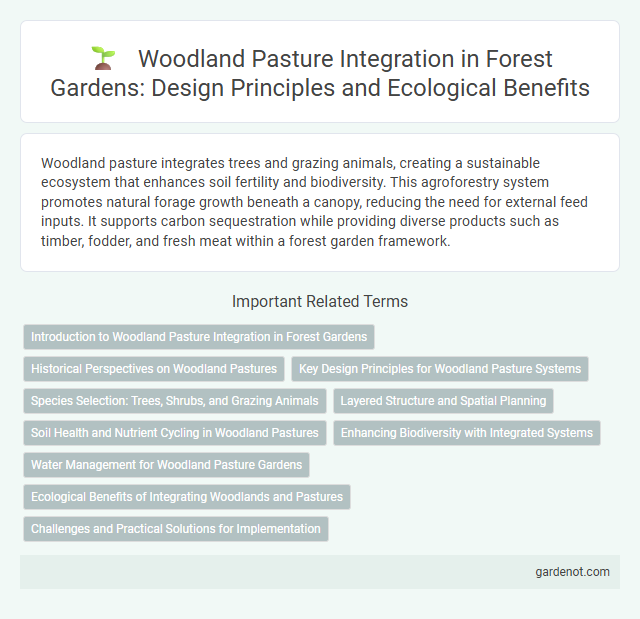Woodland pasture integrates trees and grazing animals, creating a sustainable ecosystem that enhances soil fertility and biodiversity. This agroforestry system promotes natural forage growth beneath a canopy, reducing the need for external feed inputs. It supports carbon sequestration while providing diverse products such as timber, fodder, and fresh meat within a forest garden framework.
Introduction to Woodland Pasture Integration in Forest Gardens
Woodland pasture integrates livestock grazing under a diverse canopy of trees, enhancing biodiversity and soil health within forest gardens. This practice promotes natural nutrient cycling, improves forage availability, and supports sustainable land use by combining tree cultivation with grazing animals. Implementing woodland pasture in forest gardens optimizes space and resources, creating a resilient agroforestry system.
Historical Perspectives on Woodland Pastures
Woodland pastures, historically practiced since the Neolithic era, combine tree cultivation with grazing livestock, creating a diverse ecosystem that enhances soil fertility and biodiversity. Ancient Roman writers like Pliny the Elder documented these systems for sustainable resource management, emphasizing their role in providing timber, fodder, and shelter. Archaeological evidence across Europe reveals that medieval communities maintained these multifunctional landscapes to balance agricultural productivity with environmental stewardship.
Key Design Principles for Woodland Pasture Systems
Woodland pasture systems integrate trees, shrubs, and grazing animals to create sustainable, biodiverse landscapes that optimize resource use and soil health. Key design principles emphasize spatial arrangement, species selection, and rotational grazing to balance forage availability with tree growth, ensuring ecological resilience. Maintaining structural diversity enhances habitat complexity, promoting nutrient cycling and carbon sequestration within the forest garden ecosystem.
Species Selection: Trees, Shrubs, and Grazing Animals
Woodland pasture benefits from carefully selecting tree species such as oak, ash, and hazel for their resilience and ability to provide forage and shelter, while shrubs like blackthorn and hawthorn offer vital food sources and habitat diversity. Grazing animals including hardy breeds of cattle, sheep, and pigs contribute to maintaining undergrowth and nutrient cycling, enhancing the overall ecosystem health. Strategic species selection optimizes productivity and biodiversity within a forest garden system.
Layered Structure and Spatial Planning
Woodland pasture integrates a layered structure combining tall trees, mid-sized shrubs, and ground vegetation to maximize biodiversity and resource efficiency. Spatial planning in these systems ensures optimal light penetration and root space, supporting diverse species and promoting sustainable forage production. Strategic placement of plant layers enhances soil health, microclimate regulation, and habitat connectivity within the forest garden.
Soil Health and Nutrient Cycling in Woodland Pastures
Woodland pasture integrates trees, forage, and livestock to enhance soil health by increasing organic matter and microbial diversity. Nutrient cycling is optimized as deep-rooted trees access minerals from subsoil layers, redistributing them through leaf litter and animal manure. This synergy improves soil structure, fertility, and long-term productivity in forest garden systems.
Enhancing Biodiversity with Integrated Systems
Woodland pasture combines trees and grazing animals in a managed ecosystem that enhances biodiversity by creating varied habitats and promoting nutrient cycling. Integrating diverse plant species with livestock supports soil health, pest control, and wildlife habitats, fostering ecological balance within the forest garden. This system maximizes land use efficiency while sustaining productivity and environmental resilience.
Water Management for Woodland Pasture Gardens
Woodland pasture gardens benefit from integrated water management techniques such as contour swales and permeable mulches to enhance soil moisture retention and reduce runoff. Utilizing native tree species with high transpiration rates improves groundwater recharge while supporting understory vegetation. Efficient water cycling in these systems promotes healthier forage growth and sustainable pasture productivity.
Ecological Benefits of Integrating Woodlands and Pastures
Woodland pasture combines trees and grazing land, enhancing biodiversity by creating diverse habitats for wildlife and promoting nutrient cycling through natural litter decomposition. Integrating woodlands with pastures improves soil health by increasing organic matter and supporting mycorrhizal networks, which aid plant growth and carbon sequestration. This agroforestry system reduces erosion, regulates microclimate, and offers sustainable forage production, boosting ecosystem resilience and productivity.
Challenges and Practical Solutions for Implementation
Woodland pasture faces challenges such as soil compaction, uneven tree density, and managing livestock to prevent overgrazing; these issues can be addressed by implementing rotational grazing systems and selecting tree species that tolerate grazing pressure. Maintaining biodiversity requires careful planning to balance tree canopy cover with open grazing spaces, which enhances forage availability and soil health. Using fencing strategically and integrating native understory plants also promotes sustainable woodland pasture ecosystems.
Woodland pasture Infographic

 gardenot.com
gardenot.com